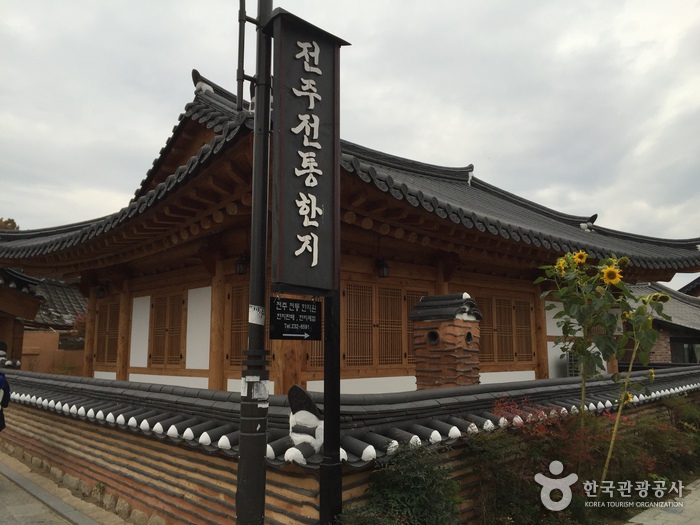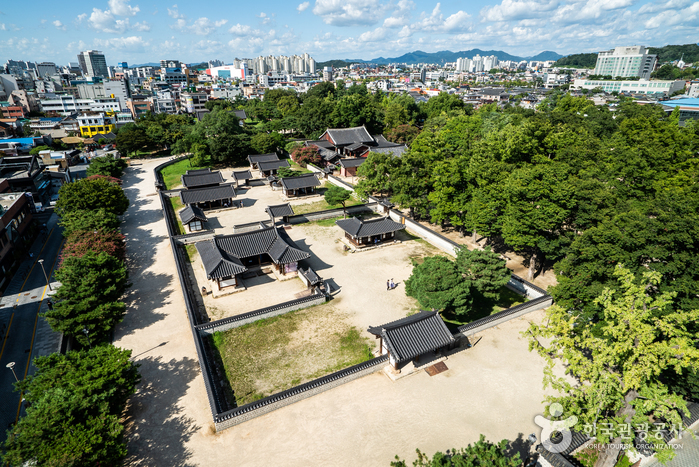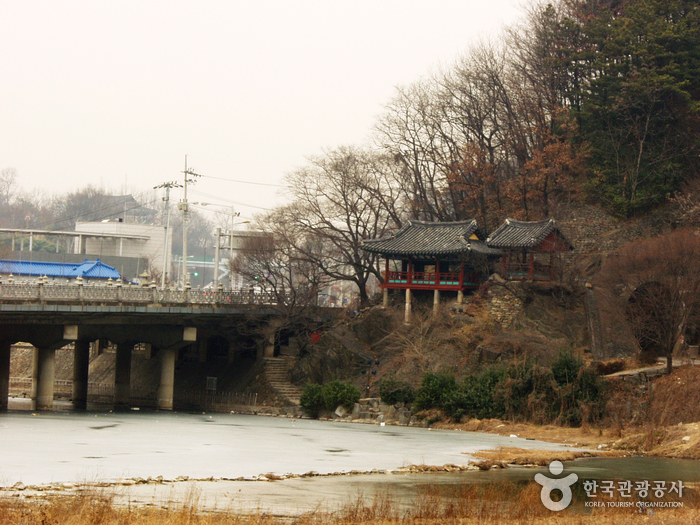Jeonju Traditional Hanji Center (전주전통한지원)
645.8852558382866m 12430 2024-04-07
100-10, Hanji-gil, Wansan-gu, Jeonju-si, Jeonbuk-do
+82-10-8959-7757
Jeonju has been a major producer of quality hanji paper for more than a thousand years. In keeping with this proud tradition, the Jeonju Traditional Hanji Center aims to preserve traditional paper-making techniques and become a mainstay in the hanji industry. More than 80 percent of the paper produced at the center is exported to Japan while the rest is used in Korea. The center produces, exhibits, and sells hanji used for calligraphy, Oriental paintings, and crafts, as well as special “yellow earth” wallpaper hanji and charcoal hanji, said to provide certain health benefits. Visitors can also sign up for crafting classes, including first-hand experience at making hanji, imprinting patterns and drying the paper.
Dan Kyung [Korea Quality] / 단경 [한국관광 품질인증]
646.4727086246791m 230 2024-04-07
99 , Hanji-gil, Wansan-gu, Jeonju-si, Jeonbuk-do
+82-10-5304-4380
Standing on Hanji-gil in Jeonju Hanok Village, Jeollabuk-do, Dankyung is a hanok stay with a more-than 80 year history that now welcomes travellers to a comfortable and cozy space. There are five accommodations altogether - four rooms in the main building, plus an annexe which is rented as a whole house. The floors are of wood, creating a delicate scent in all the rooms. Across the yard is a gallery where guests can take tea or coffee while looking at the art works on its wall. From the gallery roof, there are fine views of Jeonju Hanok Village.
Gyeonggijeon Shrine (경기전)
657.1064445944725m 55855 2024-05-27
44 Taejo-ro, Wansan-gu, Jeonju-si, Jeonbuk-do
+82-63-281-2790
A registered Historic Site, Gyeonggijeon Shrine was erected in 1410 and holds the portrait of King Tae-jo, the founder of the Joseon dynasty. The shrine was originally given the name Eoyongjeon, but was changed to its current name in 1442, the 24th year of King Sejong the Great. The structure was partially destroyed during the Imjin War (1592-1598), and was restored in 1614.
Bukyungdang [Korea Quality] / 부경당 [한국관광 품질인증]
661.3164124380107m 225 2024-04-07
99-5 , Hanji-gil, Wansan-gu, Jeonju-si, Jeonbuk-do
+82-10-5327-8736
Bukyeongdang is a traditional hanok with a beautiful garden in the center of Jeonju Hanok Village, Jeollabuk-do. Traditional roof tiles and wooden porch, jar stands next to stone walls, and a small flower garden all express characterist hanok charm. Simple cooking is possible in the shared kitchen. Visitors can store their luggage before check-in and after check-out, and tourist information is provided. The hanok is close to major tourist attractions such as Imokdae (where Joseon founder Taejo once lived) Gyeonggijeon Shrine, Jeondong Cathedral, and the Jeonju Hyanggo Confucian school).
Jeonju Nambu Traditional Market (전주 남부시장)
665.946411270107m 41911 2024-04-06
63, Pungnammun 2-gil, Wansan-gu, Jeonju-si, Jeonbuk-do
+82-63-284-1344
Jeonju Nambu Traditional Market opened as a regular public market in 1905 at the site of the Joseon-era Nammunbakk Market, located just outside the Southern gate to the city. Currently the market is comprised of about 800 stores with 1,200 workers selling vegetables, fruits, food, dried fish, furniture, silk goods, and general goods.
The market was revitalized with the creation of the Youth Market, located in the previously empty shops on the second floor of 6-dong. An influx of young shopkeepers and entrepreneurs has given the marketplace an exciting vibe like that found in Hongdae or Samcheong-dong.
The night market held on Fridays and Saturdays also draws in many visitors with a multitude of delicious treats, ranging from traditional dishes such as nokdujeon (mung bean pancake) to fusion treats like bibimbap served in rice paper like a spring roll.
Hanbyeok Tunnel (한벽터널)
668.3533957347802m 0 2024-04-06
2 , Girin-daero, Wansan-gu, Jeonju-si, Jeonbuk-do
A number of romanic and heartwarming scenes were filmed in the Hanbyeok Tunnel surrounded by ivy in the drama series "Twenty-Five Twenty-one." This place often appeared in scenes where to two main protagonists encouraged each other or soothed pain. It also appeared in the scene where the two broke up.
Ilrakdang sarangchae [Korea Quality] / 일락당사랑채 [한국관광 품질인증]
680.8958905028176m 2872 2024-04-07
15, Choemyeonghui-gil, Wansan-gu, Jeonju-si, Jeonbuk-do
+82-10-3084-6679
A must visit place for tourists in Jeonju, Ilrakdang Sarangchae is located in the middle of the traditional Korean house village of Jeonju. The very first of three enjoyments for noble man, as indicated by Menicus, the existence of parents and brothers with no troubles is what the place is named after. Standing in the garden, you can easily see the stone walls of Gyeonggijeon and also you are within the range of walking distance to Jeondong catholic church, Omokdae, Southern market, Jeonju Hyanggyo, and the wall painting village of Jaman.
The rooms are called, Haengbokchae, Sarangbang, Mitum band, Monday, Tuesday, Wednesday, Thursday, Friday, Saturday, Sunday and so on. Haengbok room 1/2, a living room with furnace, a big sized attic above the living room are shared together, which makes it most suitable for big families or a small group of tourists. The Monday/Tuesday/Friday/Saturday/Sunday rooms all have a small, cozy attic and in every guest room’s wall, column and doors are mainly made of woods which makes them feel very warm. On every morning, in the shared kitchen, simple breakfasts mainly consisting of toasts, jams, coffee and juice are served. All guests are provided with discounts on Korean costume rental(30%), motor bikes(30%) and waengi bean sprout soup with rice (1000KRW). Besides, there are various services such as introduction to tasty restaurants in partnerships with traditional Korean house villages, as well as discounts, and try out of Korean rice cake making experiences and so on.
Hanbyeokdang Pavilion (한벽당)
681.4930267996555m 16721 2024-05-28
2 Girin-daero, Wansan-gu, Jeonju-si, Jeonbuk-do
+82-63-281-5139
Located in Jeonbuk State, Hanbyeokdang Pavilion has been designated as a Tangible Cultural Property. The pavilion was built as part of a country house for a civil official from the Joseon dynasty. In the past, many writers often sought out Hanbyeokdang Pavilion to find inspiration in their writing. The pavilion is well known for the vista it offers of the beautiful surrounding mountains, thus making it one of the eight scenic beauties of Jeonju.
Ihwa Gotaek [Korea Quality] / 이화고택 [한국관광 품질인증]
694.108012656471m 12 2024-04-07
91 , Hanji-gil, Wansan-gu, Jeonju-si, Jeonbuk-do
+82-10-9668-6232
Ihwa Old House in Jeonju Hanok Village, Jeollabuk-do, is a charming hanok stay with a more than 100-year history, which preserves the traditional hanok pattern of connected wood-floored spaces called Numaru, Toenmaru and Jjongmaru. There are eight guestrooms, all equipped with a toilet. All new guests are welcomed with a glass of home-made sikhye (sweet rice drink) or patbingsu (shaved ice red bean desert), while for breakfast bibimbap or rice-cake soup will be served in Korean brass bowls. Guests can have a go at traditional crafts such as pansori, the tea ceremony, natural dyeing, and hanji making.
Jeonggahanog [Korea Quality] / 정가한옥 [한국관광 품질인증]
717.2571296821933m 177 2024-04-07
78-3 , Girin-daero, Wansan-gu, Jeonju-si, Jeonbuk-do
+82-10-9934-1300, +82-10-3677-1928
Jeongga Hanok, standing right across the road from Jeonju Hanok Village, Jeollabuk-do, is a newbuild hanok combining traditional style with modern comfort. Guestrooms are cypress-walled and red clay-grounded. Thus the Cypress room has walls and ceilings of cypress wood. The Maple room and the Gingko room both have attics. Nearby tourist attractions, which can all be reached on foot, include Gyeonggijeon Hall, Jeondong Cathedral, Jeonju Hyanggyo Confucian School, Jaman Mural Village - and of course Jeonju Hanok Village.

![Dan Kyung [Korea Quality] / 단경 [한국관광 품질인증]](http://tong.visitkorea.or.kr/cms/resource/06/2999006_image2_1.jpg)

![Bukyungdang [Korea Quality] / 부경당 [한국관광 품질인증]](http://tong.visitkorea.or.kr/cms/resource/29/2593529_image2_1.jpg)


![Ilrakdang sarangchae [Korea Quality] / 일락당사랑채 [한국관광 품질인증]](http://tong.visitkorea.or.kr/cms/resource/57/2596657_image2_1.jpg)

![Ihwa Gotaek [Korea Quality] / 이화고택 [한국관광 품질인증]](http://tong.visitkorea.or.kr/cms/resource/50/2707550_image2_1.jpg)
![Jeonggahanog [Korea Quality] / 정가한옥 [한국관광 품질인증]](http://tong.visitkorea.or.kr/cms/resource/62/2594362_image2_1.jpg)
 English
English
 한국어
한국어 日本語
日本語 中文(简体)
中文(简体) Deutsch
Deutsch Français
Français Español
Español Русский
Русский